Personalize Your iPhone Home Screen with Ease

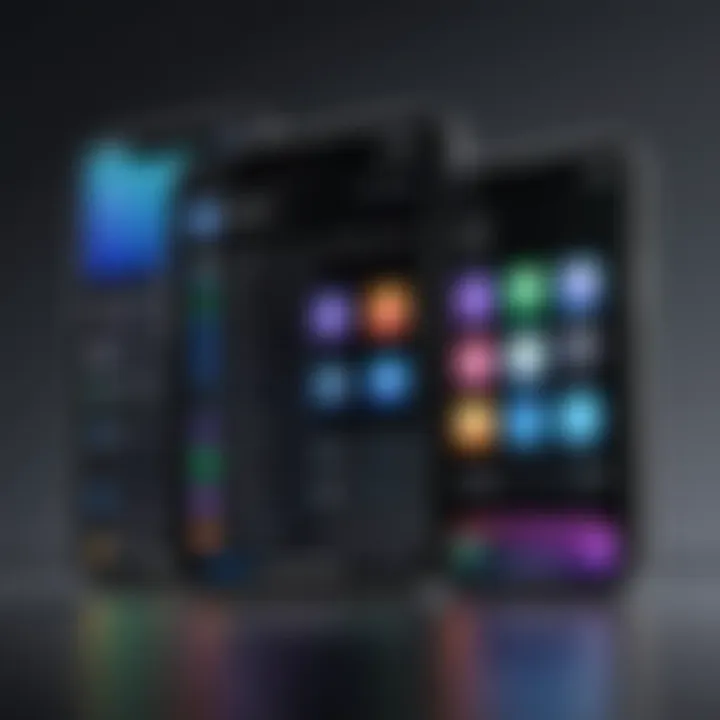
Intro
In this day and age, how we interact with our devices significantly shapes our overall experience. For iPhone users, the home screen serves as a personal canvas of sorts, where intricate designs and functional layouts collide with individual preferences. Customizing your home screen isn't simply a stylistic choice; it's an opportunity to enhance efficiency, streamline access to your favorite apps, and put your unique flair on your device.
Whether you’re a gadget aficionado or someone who just enjoys a bit of personal expression, diving into the realm of home screen customization can be incredibly rewarding. With each update from Apple, new options arise, enabling you to tailor your device like never before. The following sections will unpack various methods for achieving an engaging home screen that meets both your functional needs and aesthetic desires.
Foreword to Home Screen Customization
In today's fast-paced digital world, the way your smartphone looks and feels can significantly influence your interaction with it. The iPhone home screen is not just a backdrop for your applications; it's a canvas that reflects your personal style and organization, which can enhance not only aesthetics but also usability. By customizing your home screen, you are effectively asserting control over your digital space, making it more conducive to your needs and preferences.
Why is this important? The importance of home screen customization lies in its ability to streamline your daily tasks and foster a sense of ownership. When your most-used apps are easily accessible, it can save you valuable time. Moreover, having a personalized home screen can improve your mood and enhance your overall user experience. For instance, if you often check the weather, placing that app front and center can save you from endless scrolling.
Additionally, with the rise of remote work and the increased reliance on technology, a well-organized home screen can help you maintain focus and productivity. Apps neatly arranged into folders or placed according to your workflow can make navigating through the day less cumbersome.
However, it’s not just about placing icons where they fit; careful consideration of design aesthetics plays a crucial role. A visually appealing and well-organized home screen can bring a sense of tranquility amidst the chaos of notifications and schedule alerts. Think about your favorite color scheme or a theme that resonates with you—each time you pick up your device, those choices can evoke positive feelings.
"Your home screen is your digital footprint; it should serve your needs and reflect who you are."
Ultimately, home screen customization isn't merely a trend; it's a vital aspect of maximizing your iPhone usage. It combines functionality with personal expression and paves the way for a tailored user experience. As we dive deeper into specific customization methods in this guide, keep in mind the practicalities of your daily life and how customization can contribute to a seamless, enjoyable interaction with your device.
Understanding iOS Customization Features
Understanding the customization features available in iOS is not just about aesthetics; it's a gateway to creating a seamless user experience that matches your unique lifestyle. In the era where personalization is king, the way you set up your iPhone's home screen can significantly impact how you interact with your device. When done right, customization can enhance efficiency and make navigation more intuitive. From rearranging apps to utilizing widgets and beyond, every little adjustment can streamline your daily tasks and reflect your personality.
Overview of iOS Versions
Apple has continually evolved its iOS platform, each version bringing something fresh to the table. To make the most out of your customization efforts, knowing which iOS version you're using is fundamental. For example, iOS 14 marked a pivotal shift in customization capabilities, introducing widgets that weren't just functional but also incredibly stylish. Later versions followed suit, expanding on what was possible, such as Live Text in iOS 15 and the Focus modes in iOS 16 that allow for specific setups based on your current activity.
- iOS 14: Introduced widgets on the home screen for the first time. This flexibility allowed for dynamic, glanceable information at your fingertips.
- iOS 15: Enhanced widget capabilities, making it easier to stack them for even more information in less space.
- iOS 16: Brought about Focus modes, allowing users to customize app notifications, home screens, and even which widgets are shown based on activities like work or leisure.
All these advancements not only improve how you interact with your device but also contribute to a more personalized experience when managing your apps and information.
Native Customization Tools
Apple's ecosystem brings a suite of native tools designed to empower users to tailor their experience. These tools are built right into the iOS interface, ensuring a smooth and cohesive customization process. Here are some key tools you should be familiar with:
- Home Screen Layout: You can freely rearrange app icons and create folders. This lets you prioritize the apps you use most frequently, putting them front and center.
- Widgets: Beyond the basic functionalities, widgets come in various sizes and formats, allowing you to display weather, calendar events, or even news updates in a format that fits your needs.
- App Library: Introduced in iOS 14, it organizes all your apps in one place, making it easier to declutter your home screen and find what you’re looking for without endless scrolling.
- Focus Modes: These allow you to create different environments that cater to your daily activities. You can set specific home screens to show only the apps relevant to your task at hand, whether that’s work or relaxation.
With these tools at your disposal, you’re not just moving icons around; you're building an entire user interface tailored to your preferences.
"Apple's native customization tools enhance both functionality and personal expression, allowing users to create their ideal digital workspace."
Understanding these features is crucial if you want to take full advantage of the customization potential iOS offers. It's not just about making your iPhone pretty; it's about improving how you use your device in your everyday life.
Choosing a Home Screen Layout
The layout of your iPhone home screen is akin to the foundation of a house; without a solid base, everything built upon it can feel unsteady. An organized and visually pleasing home screen layout not only enhances the functionality of your device, but also reflects your personal taste. In a world where first impressions matter, making your home screen appealing can elevate your user experience significantly.
Grid Systems and Icon Placement
When it comes to home screen layouts, grid systems are essential. The iPhone uses a grid format that allows icons to be arranged neatly, optimizing the available screen real estate. This grid can be altered through icon placement and helps to create a logical flow for app access.
Consider these elements when planning your layout:
- Frequency of Use: Place the apps you use most often in easily accessible positions. For example, your messaging and navigation apps could go on the first page, while less frequently used ones can slide further in.
- Visual Harmony: Group similar apps together. For instance, if you often use photo editing apps, consider placing them adjacent to each other. This method not only makes sense functionally but also offers a more organized appearance.
- Aligning Icons: Make sure that the icons are aligned to create a symmetrical look. This minor adjustment can make a significant difference in how visually appealing your home screen appears. Icons bouncing around aimlessly can be distracting and may undermine the overall aesthetic you want to achieve.
The Role of Folders
Folders play an integral part in creating a tidy layout and maximizing functionality. By categorizing applications into folders, you can reduce clutter and simplify navigation. When you have multiple social media apps or health tracking applications, a folder can encapsulate these into a neat package.
Here are a few tips for effective folder management:
- Descriptive Naming: Use clear and intuitive names for folders. Instead of a generic label like "Miscellaneous," try something like "Social" or "Fitness." This offers immediate clarity about what apps are housed within.
- Limit Folder Size: Too many apps in a single folder can be counterproductive. Instead of cramming every related app together, limit each folder to a manageable number. This keeps navigation quick and efficient.
- Regularly Review and Update: As you download new apps and modify your usage habits, take time to revisit your folders. Clear out apps that you no longer use or reorganize them to better suit your current needs. Regular maintenance of your folders can keep your home screen as fresh as a daisy.
"An organized home screen isn’t just about aesthetics; it speaks volumes about productivity and efficiency."
Utilizing Widgets
Widgets have revolutionized the way we interact with our iPhones. They serve a pivotal role in enhancing not just the aesthetics but also the functionality of your home screen. By offering dynamic information at a glance, widgets can streamline your daily tasks, making it easier to access what you need without diving deep into apps. Whether it’s checking the weather, monitoring your fitness progress, or staying updated with your calendar, these tools can elevate your user experience. Moreover, customizing widgets allows you to align your home screen with your personal style, creating a space that’s uniquely yours.
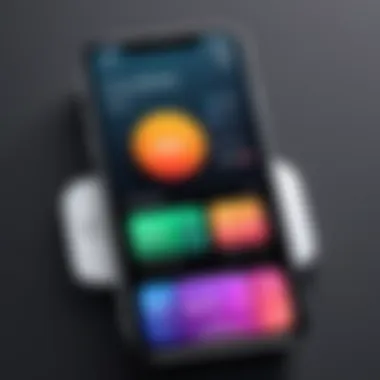
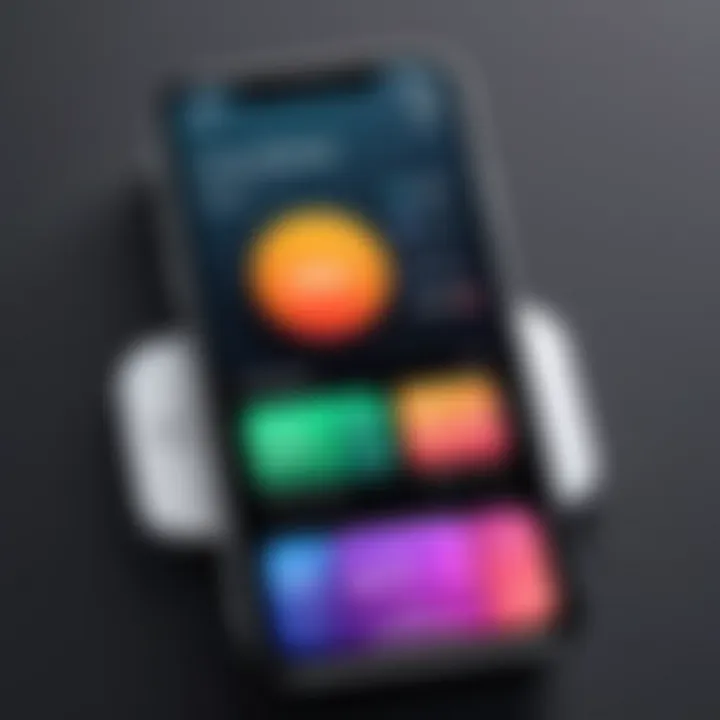
Types of Widgets Available
Widgets come in various forms, tailored to different functionalities and user preferences. Here are a few notable categories:
- Informational Widgets: These display essential data like weather updates, news headlines, or calendar events. For instance, the Calendar widget can show your upcoming meetings directly on the home screen, saving you a few taps.
- Utility Widgets: Aimed at enhancing productivity, these can include tools like reminders, timers, or shortcuts to frequently used apps. For example, a Notes widget can present quick access to your latest notes without hassle.
- Media Widgets: Perfect for music lovers, these widgets can control playback and show the current song, allowing for seamless transitions between tracks.
In addition, many third-party apps provide their own unique widgets, adding even more variety to your options.
Best Practices for Widget Placement
Navigating the placement of widgets is all about balance and organization. Here are some guidelines to optimize your setup:
- Prioritize Functionality: Place frequently used widgets in prominent positions. For example, if you often check the weather, put that widget at the top of the screen for quick access.
- Group Similar Widgets: Try placing widgets of similar functionality together. A fitness tracker, health app, and step counter, for instance, can coexist in one area, keeping your home screen organized and user-friendly.
- Maintain Aesthetics: Think about the visual flow of your home screen. Mixing different sizes and colors can create a chaotic look. Aim for a cohesive theme—whether it’s minimalist or vibrant—to please the eyes as well.
How to Add and Edit Widgets
To make the most out of widgets, it’s essential to know how to add and edit them. The process is straightforward:
- Adding Widgets:
- Editing Widgets:
- Press and hold anywhere on the home screen until the apps jiggle.
- Tap the “+” icon in the corner to access the widget menu.
- Browse through available widgets from Apple and other apps.
- Choose your preferred widget size and then tap “Add Widget.”
- To adjust a widget, simply long-press it until the options appear.
- Tap “Edit Widget” to customize settings such as the specific calendar or weather location.
- If the widget allows it, you might also adjust the size here.
This way, you can tailor what information you see at a glance and how it appears, ensuring your home screen remains both functional and aesthetically pleasing.
Customization is not just about looks; it's about creating an experience that caters to your needs and preferences.
Personalizing App Icons
In the realm of customizing an iPhone, app icons hold significant weight. They serve not just as gateways to our digital experiences but also as expressions of personal style. With the proper personalization methods, you can transform a mundane app grid into a unique showcase reflecting your personality and preferences. The benefits of personalizing app icons include enhanced visual appeal, improved accessibility for frequently used apps, and a smoother navigation experience.
The allure of a well-curated home screen stems from its ability to engage both aesthetically and functionally. A customized app icon can turn a everyday task into a more delightful interaction. It lays the groundwork for an organized and tailored environment that showcases individuality, making the device feel more intimate and integrated into your life.
Custom Icon Designs
Custom icon designs allow users to craft a visual narrative that resonates more closely with their identity. The journey begins with selecting an aesthetic theme, such as minimalist graphics or vibrant illustrations. This decision can radically shift the overall feel of the home screen. For example, opting for pastel-colored icons can evoke calmness, while bold and bright designs might induce energy. Tools like Canva or Adobe Spark can offer a pathway for users willing to delve into graphic design.
Once an ideal design is in mind, creating or sourcing custom icons becomes vital. Users can either make their own with design tools or download pre-made packs from websites like Etsy and Reddit. Here’s a basic outline of steps to get started:
- Choose an aesthetic theme that reflects your style.
- Use design tools to create your icons or buy premade ones.
- Organize your icons into categories or color themes for cohesive look.
- Export the images in a compatible format for iOS.
Using Shortcuts for Customization
One of the most effective ways to personalize app icons is by using the Shortcuts app on your iPhone. This app can transform mundane icons into visually stunning representations of your selected apps. Plus, it allows for an additional level of customizability—each shortcut acts as a hub, connecting to the desired app while presenting a unique icon.
To make this customization seamless, follow these steps:
- Open the Shortcuts app. Tap on the ‘+’ icon to create a new shortcut.
- Select ‘Add Action’ and then choose the ‘Open App’ action.
- Tap on ‘Choose’ and select the app you want to customize.
- Name your shortcut accordingly and change the icon. You can either choose from the available options or select a photo from your library.
- Add it to your home screen by tapping on the icon in the top right, selecting ‘Add to Home Screen’ and naming it.
By utilizing these steps, you can not only personalize app icons but also strategically enhance the practicality of your home screen.
"Customizing your iPhone with personalized app icons creates a user experience that is as delightful as it is functional. An organized home screen can markedly change the way apps interact with daily life, increasing efficiency and joy."
Creating a Thematic Home Screen
Creating a thematic home screen can transform your iPhone experience from mundane to exceptional. This is not merely about aesthetics; it’s about crafting a digital environment that reflects your personality while enhancing your interaction with the device. A cohesive theme can lead to easier navigation, increased productivity, and a sense of satisfaction every time you unlock your phone.
When you think about a thematic home screen, consider how it can represent your tastes and interests. Whether you love minimalism, vibrant colors, or an artistic flair, aligning your icons, widgets, and wallpaper creates harmony. More importantly, such personalization can help you find and access your favorite apps quickly. It's like having your own personalized workspace.
Here are a few aspects to keep in mind when creating a thematic home screen:
- Consistency: Make sure your colors and design elements work together. This creates a pleasing visual flow.
- Identifiability: Choose themes that make your frequently used apps easy to spot. This saves time and improves efficiency.
- Expression: Let your personality shine through your theme. After all, your home screen is an extension of you.
"An organized home screen is a reflection of a well-organized mind."
Color Schemes and Aesthetics
When it comes to color schemes, this is where creativity can really flow. Color influences mood and perception; hence, it's crucial to pick hues that either energize you or provide a sense of calm. Think about what colors resonate with you. For example, soft pastels can evoke tranquility, while vibrant hues can lift your spirits. Here are some tips on choosing a color scheme:
- Choose a Base Color: This will be the star of the show. It sets the tone for your theme.
- Complementary Colors: These are colors opposite on the color wheel that enhance the primary color without overpowering it.
- Accent Colors: Use these sparingly for icons or texts, ensuring they stand out yet blend harmoniously with the base color.
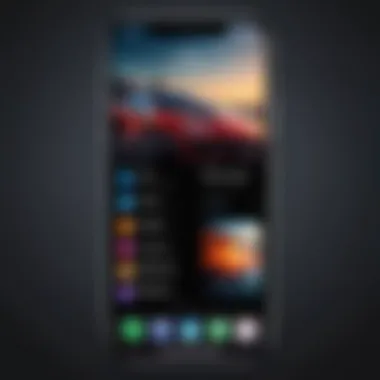
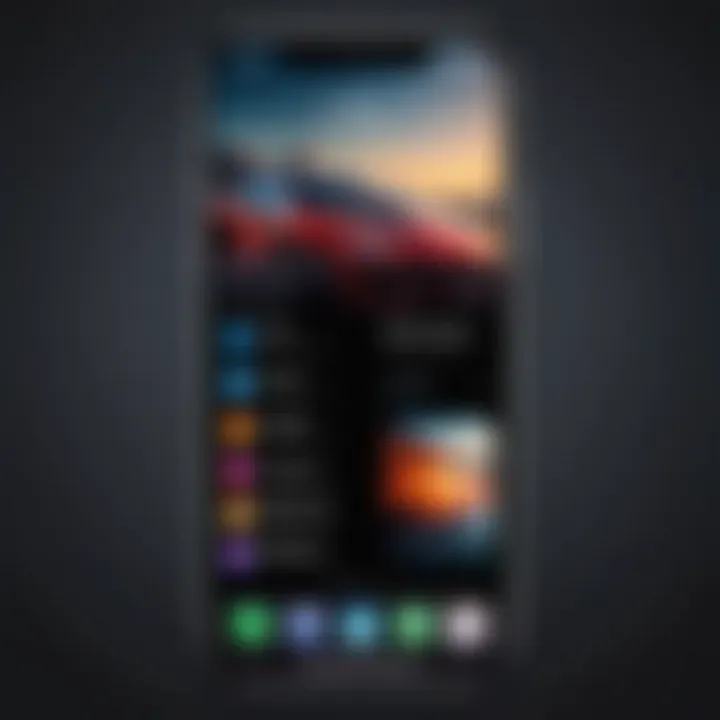
Some popular palettes might include combinations like:
- Navy blue paired with gold for an elegant touch.
- Soft pink with white and mint for a fresh look.
- Earthy tones like browns and greens for a natural feel.
Incorporating Visual Elements
After settling on your color scheme, incorporating visual elements completes the overall aesthetic. This could be through customized wallpapers, unique widget designs, and artwork that speaks to you. The aim is to create a visually inviting space on your home screen. Here’s how:
- Use Stunning Wallpapers: Opt for high-resolution images that resonate with your theme. Websites like Unsplash offer free wallpapers that can elevate your home screen.
- Select Custom Icons: If you stick to a specific aesthetic, themed icon packs are available on various platforms. This can unify your apps in a way default icons cannot.
- Interactive Elements: Widgets are more than just informers; they can blend beautifully into your theme. Choose widget styles that align with your color scheme and aesthetic approach.
Managing Notifications and App Alerts
In today’s fast-paced digital world, managing notifications and app alerts on your iPhone is not just a matter of preference; it has become essential for maintaining focus and enhancing productivity. With the seemingly endless stream of alerts from various apps, organizing these notifications can significantly improve your user experience. It's not merely about turning off sounds or vibrations; it involves creating a setup that allows you to prioritize what's important while minimizing distractions.
Configuring Notification Settings
To kick things off, navigating to the Settings app is your first step. Look for the Notifications tab—you'll find a treasure trove of options here. Each app has individual settings, allowing you to tailor how you want to be alerted. Here’s how to configure them effectively:
- Turn Off Unnecessary Notifications: If an app pushes too many alerts that don't add value, consider turning them off. For instance, a fitness app may not need to send you reminders every time you achieve a small milestone.
- Customize Alerts: Different apps cater to different needs. The weather app might deserve a loud alert if there's a storm brewing, while a social media notification can be subtle. Use settings like banners, alerts, or badges accordingly.
- Schedule Notifications: Some apps allow you to schedule when you'd like to receive notifications. If you're trying to focus on work, setting them for before or after working hours can be an effective way to manage your time better.
By taking control of these settings, you create a personalized notification experience that resonates with your specific needs and lifestyle.
Balancing Notifications with Home Screen Design
Just as the notifications you receive are essential, so is how they interact with the overall design of your home screen. A cluttered screen with numerous alert badges can lead to a chaotic experience, undermining your efforts at organization. Here’s how to ensure balance:
- Strategic Icon Placement: Icons of apps that send frequent notifications can be grouped in a folder. This keeps them within reach while also minimizing visual noise. For example, consider putting social apps in a folder on one page, distinct from work-related icons.
- Use Focus Modes: The iPhone has a feature called Focus that lets you customize app notifications based on your current activity—be it work, personal time, or sleep. Enabling Focus can hush non-essential notifications during working hours, allowing you to maintain a serene home screen aesthetic.
- Regular Reviews: Schedule a periodic review of your notification settings and app placements. Technology evolves and so do our needs. Take a look every few months to see if your arrangements still serve you well.
"An organized home screen coupled with efficient notification settings creates a functional and enjoyable user experience."
The balance you achieve between notifications and home screen design can dramatically enhance your iPhone usage, fostering a clearer mind and increased productivity. The importance of tuning into both aspects cannot be overstated—it’s about crafting an environment that reflects your priorities and passions.
By managing notifications judiciously and curating your home screen thoughtfully, you'll take substantial strides toward a more efficient and personalized mobile experience.
Integrating Third-Party Apps
In the realm of personalizing your iPhone’s home screen, the integration of third-party apps serves as a pivotal element. It's not just about arranging app icons in a visually striking layout; it's about expanding the functionality and versatility of your device. Often, native settings and apps might have certain constraints, but third-party applications can fill those voids quite nicely, offering a unique user experience that resonates with individual preferences.
Third-party apps can enhance productivity, streamline daily tasks, and provide diverse customization options that default apps may lack. When tapping into this expansive well of options, it’s crucial to assess which apps complement your routine and lifestyle, ensuring an optimized home screen arrangement. This adjustment can elevate both aesthetic appeal and usability, creating a home screen that’s not only pleasing to the eye but also functional.
Recommended Apps for Customization
Several third-party applications can significantly extend the customization options of your iPhone home screen. Here’s a selection worth considering:
- Widgetsmith: This app offers versatile widget options that allow you to personalize your widgets' size and appearance. You can choose from different styles, fonts, and even add images to make your home screen truly yours.
- Color Widgets: Like Widgetsmith, Color Widgets provides an array of styles to display important information. This app stands out with vibrant designs and the ability to customize backgrounds, making your home screen pop.
- Custom Icons: Apps such as FancyIcons let you create custom app icons and aesthetics, providing a way to transition away from the usual default look.
- Shortcuts: While technically a part of iOS, utilizing this app alongside third-party ones enables powerful automation for your apps. It can increase efficiency through streamlined workflows.
- Launch Center Pro: A productivity app that allows you to create custom shortcuts for your favorite actions or apps. Its flexibility can help declutter your home screen.
These applications can breathe new life into your device. Start by trying a couple out before diving into an extensive overhaul.
Using Automation to Enhance Functionality
Automation has become increasingly essential in maximizing the potential of your device. By leveraging apps like Shortcuts, you can create specific commands that trigger a series of tasks with just a tap. This means, for instance, consolidating multiple actions into a single shortcut when you arrive home, like turning on Wi-Fi, opening a news app, and sending a message to a loved one.
Creating automated tasks not only saves time but also enhances the overall experience by making your iPhone more responsive to your daily needs.
Consider these examples of how automation can enhance functionality:
- Morning Routine Shortcut: Set up an action that will send a message, play a specific podcast, and turn on your morning playlist all at once.
- Location-Based Automations: Have your phone automatically adjust volume settings or launch specific apps whenever you arrive at work or head to a coffee shop.
- Single-Tap Actions: Create a single icon on your home screen that handles often-used tasks in a sequence, such as sending a text to your family letting them know you’re on your way.
Incorporating these elements into your home screen not only makes it functional but also turns it into a tool that syncs seamlessly with your life. By taking the time to integrate third-party apps and utilize automation strategies, you are crafting an iPhone experience that is uniquely yours.
Maintaining an Organized Home Screen
Having a well-organized home screen is more than just a matter of aesthetics; it's the difference between a phone that's a breeze to navigate and one that feels chaotic and cluttered. A tidy home screen allows users to access their most-used apps quickly, reduces the time lost searching for icons, and ultimately creates a more efficient mobile experience. Additionally, an organized setup can help you maintain your focus and minimize distractions, as you have a clear space reserved for what matters most—your essential applications and widgets.
Regularly Updating Your Setup
Technology and user habits change, and so should your home screen layout. Regular updates ensure that your configuration aligns with your current needs. For instance, if you've recently started using a new app frequently, it makes sense to relocate it to an easily accessible position on your home screen. In contrast, apps that once held your interest might be gathering digital dust.
Consider scheduling a monthly review to assess your home screen:
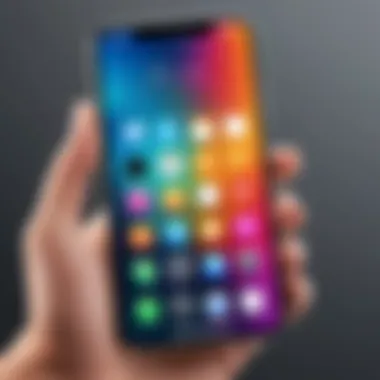

- Evaluate your app usage: Check which apps you frequently use and which ones are just taking up space.
- Rotate widgets according to seasons or interests: For example, weather widgets can be replaced with fitness apps during the summer months if you’re hitting the gym harder.
- Stay ahead of software updates: Ensuring your applications are up-to-date often means new features that can enhance your experience.
Taking the time to refresh your setup can breathe new life into how you interact with your device.
Adapting to Personal Usage Changes
Life is full of changes, and your iPhone usage might reflect that. For instance, if your weekends are now spent on hobbies that require different apps, don’t hesitate to shuffle your icons around. This personalization leads to smoother and more intuitive navigation.
Here are a few strategies for adapting your home screen to changing needs:
- Group similar applications: If you've taken up a new hobby, it might be handy to create a folder specifically for related apps, such as photography or music creation.
- Leverage the newest features: Stay informed on the latest iOS updates. Utilize new tools that can enhance your workflow. If, for example, a new feature supports better organization, implement it to streamline your experience.
- Assess emotional needs: Sometimes, a messy screen can feel overwhelming. Keeping your digital space in order can lead to a calmer mindset. It might be worthwhile to set simple rules, like keeping only a specific number of apps visible to avoid clutter.
"An organized space fosters an organized mind."
With these points in mind, you're now better equipped to create a home screen that not only reflects your personal style but also supports your productivity.
Troubleshooting Common Issues
When you're deep into the weeds of customizing your iPhone home screen, you may run into a few bumps along the road. It's crucial to understand how to troubleshoot common issues that could thwart your efforts and dampen the experience. This section covers the essentials of addressing these challenges. Having a streamlined and personalized home screen is key to daily efficiency, and knowing how to fix issues ensures that your customization efforts pay off in the long run.
Misconfigured Widgets and Icons
Widgets are great for quick information at a glance. However, they can sometimes misbehave, showing incorrect data or not displaying at all. This can be frustrating when you expect to see a weather update or a calendar event right there on your home screen. Here are some common problems and how you might tackle them:
- Check Widget Settings: Make sure you've configured the widget settings correctly. Usually, a tap and hold on the widget brings options up to edit. Ensure all relevant options, like location for weather widgets, are properly set.
- Update Frequency: Sometimes, widgets don’t refresh as frequently as you need. Look at the refresh settings in the app and see if they align with your expectations. Some widgets can even be set to refresh only when the app is open.
- Icon Shortcuts: If you’ve customized your icons and they aren’t working right, this could be due to misconfiguration within the Shortcuts app. Be sure that the original app is still correctly linked to the new icon. Recreating the shortcuts can also permanently fix any glitches.
"A little tweaking here and there goes a long way in perfecting your display!"
By keeping an eye on these aspects, you can maintain a flawless widget performance while enjoying a visually pleasing layout.
Dealing with Software Limitations
It’s no secret that software, even from Apple, is not bulletproof. Occasionally, you might run into software limitations that hinder the level of customization you can achieve. Understanding these limitations can help you find workarounds or adjust your expectations.
- iOS Version Compatibility: Ensure you're running the latest version of iOS. Older versions might lack features that enable better customization, or they could have bugs that affect how widgets and icons behave.
- Limited Widget Choices: Some users might be surprised to find that not all apps offer widgets. While some apps may have extensive customization options, others might only have basic ones, which can be a letdown if you're trying to maintain a consistent aesthetic.
- Storage Issues: Sometimes, performance hiccups could stem from low storage on your device. If your iPhone is stuffed to the gills, it might affect how smoothly the interface operates—for example, causing issues with loading icons or widget updates.
To navigate these limitations, keep your device updated, consider using lightweight alternatives for certain apps, and manage storage wisely. Regularly reviewing your apps can save you a lot of headaches down the line.
Future Trends in Home Screen Customization
As technology progresses at an alarming rate, the way we interact with our mobile devices evolves too. Future trends in home screen customization will be instrumental in shaping how users engage with their iPhones. The relevance of this topic lies not just in aesthetics, but also in functionality and personal expression. Upcoming features might redefine user experience, making customization more accessible and intuitive. For instance, the integration of artificial intelligence could lead to adaptive home screens that change based on user habits and preferences.
By anticipating these trends, users can prepare themselves to fully leverage these advancements. As we delve deeper, understanding the importance of staying ahead in the game gives users a sense of empowerment over their devices, turning an ordinary tool into an extension of personal identity.
Anticipating iOS Updates
One of the most exciting aspects of anticipating iOS updates is the potential for enhanced customization options. Apple regularly introduces features that allow users to tailor their home screens further. For example, recent updates brought live activities and enhanced widget capabilities, but what can we expect next?
- Dynamic Widgets: Imagine widgets that change contextually based on time, location, or real-time data. For instance, a weather widget that not only shows the temperature but also changes appearance based on the current weather conditions.
- App Suggestions: Future updates might bring smart algorithms capable of learning user patterns, suggesting which apps to place on the home screen according to usage times or specific events.
- Improved Shortcuts: Enhancements in the Shortcuts app could allow for even more creative and customized app flows, permitting users to set automated tasks based on triggers, like arriving home or starting their day.
These advancements are not just about eye candy; they are about optimizing the user experience, creating a more intuitive interaction with the device.
Emerging Technologies in User Interface Design
The landscape of user interface design is constantly changing, and new technologies will play a pivotal role in customizing the iPhone home screen. As gadgets become more sophisticated, the user experience must evolve alongside them. Here are some notable trends to consider:
- Augmented Reality (AR): Envision an interface where users can interact with apps and features in their physical environment. For instance, AR could enable widgets that overlay pertinent information directly into users' surroundings.
- Voice User Interface (VUI): As voice assistants get smarter, we may see a significant shift towards voice-driven customization. Imagine telling Siri not only to open an app but to reorganize the home screen or to adjust settings based on your spoken preferences.
- Gesture Recognition: More advanced gesture controls could mean users might navigate their home screens with swipes and movements rather than taps alone. Interaction design will become more fluid, catering to the user’s natural tendencies.
With these technologies lurking on the horizon, iPhone users have an exciting future ahead in managing their home screens. Keeping an eye on how these technologies develop will allow one to stay ahead of the curve, ensuring that personalized devices remain not just a trend but a norm.
Finale and Final Thoughts
In wrapping up our deep dive into customizing your iPhone home screen, it becomes clear that personalization isn't just the cherry on top; it’s a fundamental element that enhances usability and reflects our individual styles. The home screen is often the first stop in daily interactions with our devices, so it stands to reason that an effective design can lead to more seamless functionality.
The significance of tailoring your space can't be overstated. Being able to arrange apps, widgets, and backgrounds according to your preferences not only boosts your productivity but also brings a sense of joy every time you unlock your device. Personalization allows you to create an experience that caters to your habits and needs.
Benefits of Home Screen Customization
- Increased Efficiency: An organized layout means faster access to frequently used apps. When you've got essential tools at your fingertips, you're bound to save time.
- Aesthetic Appeal: Custom icons and themes give your iPhone a unique flair. It’s like owning a one-of-a-kind piece instead of a standard setup.
- Functionality: With widgets, you can get quick updates on weather, news, or your calendar, melding aesthetics with practicality.
Considerations
While customization is a fantastic way to make your device feel like your own, it’s important to keep user-friendliness in mind. A cluttered screen may lead to frustration when you're looking for that one app hidden behind layers of folders and widgets. Balance is key.
"Simplicity is the ultimate sophistication." This holds true for your home screen as well. Don’t be afraid to strip back unnecessary clutter and focus on what truly enhances your daily life.
Ultimately, the customization of an iPhone home screen should serve to simplify and enrich everyday tasks. Embracing this flexibility enables users to craft an interface that aligns with their own lifestyle choices and preferences, paving the way for a more intuitive user experience.







